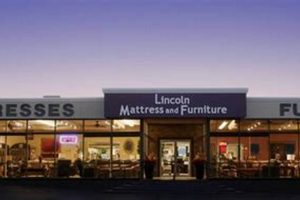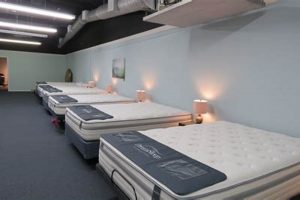The offerings from the state known for its rich tradition of furniture craftsmanship and bedding solutions are extensive. This encompasses a wide array of home furnishings, ranging from handcrafted wooden pieces to mass-produced upholstered items, alongside sleep products designed for comfort and support. One can expect to find items suitable for various rooms within a household, including living rooms, bedrooms, dining rooms, and home offices.
The significance of this manufacturing sector lies in its contribution to the local economy and its legacy of quality. The region’s furniture industry has historically provided employment opportunities and cultivated a reputation for producing durable and aesthetically pleasing goods. Customers benefit from a diverse selection, competitive pricing, and the potential for supporting local artisans and businesses.
This article will delve into the specifics of material sourcing, common construction techniques, popular design trends, and key retailers associated with this sector. Further discussion will address the sustainability practices within the manufacturing process and the overall economic impact on the region.
Tips for Selecting Durable Home Furnishings and Bedding
This section provides practical guidance for individuals seeking to invest in long-lasting furniture and mattresses. Informed purchasing decisions contribute to both value and satisfaction.
Tip 1: Prioritize Frame Construction. Solid hardwood frames, particularly those crafted from kiln-dried wood, offer superior stability and resistance to warping compared to particleboard or softwood alternatives. Examine joinery methods such as mortise-and-tenon or dovetail joints for enhanced structural integrity.
Tip 2: Assess Fabric Durability. Opt for tightly woven fabrics with high thread counts. Performance fabrics, engineered for stain resistance and abrasion, are recommended for households with children or pets. Consider natural fibers like linen or cotton blends for breathability and comfort, but be mindful of their maintenance requirements.
Tip 3: Evaluate Mattress Support Systems. Innerspring mattresses should feature tempered steel coils for optimal support and longevity. Memory foam mattresses should have a high-density foam core to prevent sagging. Consider a hybrid mattress for a combination of support and comfort.
Tip 4: Examine Upholstery Details. Look for straight, even seams and consistent pattern matching on upholstered furniture. Tight back and seat cushions indicate quality craftsmanship. Inspect the welting and trim for secure attachment and clean lines.
Tip 5: Inquire About Warranty Coverage. Reputable manufacturers offer warranties that protect against defects in materials and workmanship. Review the terms and conditions carefully to understand the scope of coverage and claim procedures.
Tip 6: Consider Weight Capacity. Before purchasing seating or beds, verify the maximum weight capacity to ensure suitability for intended users. Exceeding weight limits can compromise structural integrity and reduce product lifespan.
Tip 7: Research Manufacturer Reputation. Investigate the manufacturer’s history, customer reviews, and industry certifications. Establishments with a proven track record of quality and customer service are generally a safer investment.
Selecting home furnishings and bedding requires careful consideration of materials, construction, and manufacturer reputation. By adhering to these guidelines, consumers can make informed decisions that result in durable and satisfying purchases.
The subsequent section will discuss the environmental impact of furniture and mattress production, as well as strategies for responsible disposal and recycling.
1. Craftsmanship
Craftsmanship forms a cornerstone of the furniture and mattress sector within North Carolina. It signifies more than mere manufacturing; it embodies a dedication to quality, precision, and the enduring legacy of furniture making traditions within the state. The emphasis on artisanal skill directly influences the perceived value and longevity of the products originating from this region. Skilled artisans often employ techniques passed down through generations, resulting in distinctive pieces characterized by intricate detailing and robust construction. This commitment to quality serves as a differentiating factor, distinguishing products from mass-produced alternatives and establishing a reputation for superior workmanship.
The importance of craftsmanship can be observed in specific product attributes. For instance, solid wood furniture featuring hand-carved accents or meticulously applied finishes reflects the dedication of skilled craftspeople. Similarly, mattresses constructed with hand-tufted details and precisely aligned coils demonstrate a commitment to quality and comfort. The ability to identify and appreciate these nuanced details can empower consumers to make informed purchasing decisions, prioritizing durability and aesthetic appeal. Furthermore, the employment of experienced artisans directly contributes to the economic vitality of local communities, preserving valuable skills and fostering a culture of excellence.
In summary, craftsmanship is inextricably linked to the essence of the North Carolina furniture and mattress industry. It provides a tangible measure of quality, contributes to the economic well-being of the region, and reflects a commitment to upholding time-honored traditions. While the industry faces challenges from global competition and evolving consumer preferences, the continued emphasis on craftsmanship remains a crucial differentiator and a testament to the enduring value of skilled labor.
2. Material Sourcing
The origin of materials used in furniture and mattress manufacturing significantly impacts the quality, sustainability, and overall cost of finished products. In the context of North Carolina’s furniture industry, material sourcing encompasses both the procurement of domestically harvested hardwoods and the acquisition of imported components, including textiles, metals, and synthetic foams. The decisions made regarding these sources directly affect the durability, aesthetic appeal, and environmental footprint of the furniture and mattresses produced. For example, the selection of sustainably harvested Appalachian hardwoods contributes to the longevity of wood furniture, while the use of low-VOC (volatile organic compound) adhesives and finishes minimizes potential health risks for consumers. The ability to trace the origin of materials and ensure compliance with environmental regulations is therefore crucial for maintaining the reputation and competitiveness of the region’s manufacturers.
The economic implications of material sourcing are also noteworthy. The furniture industry’s demand for raw materials supports local forestry operations and related businesses. Conversely, reliance on imported materials can expose manufacturers to fluctuations in global commodity prices and supply chain disruptions. Many North Carolina manufacturers have adopted strategies to mitigate these risks, such as diversifying their supplier base and investing in vertical integration to control material costs. Furthermore, the increasing demand for eco-friendly products has prompted manufacturers to prioritize sustainable material sourcing practices, including the use of recycled content and the adoption of responsible forestry management techniques. For instance, some companies have partnered with environmental organizations to promote sustainable harvesting practices and ensure the long-term availability of high-quality wood resources.
In summary, material sourcing is a critical determinant of the quality, sustainability, and economic viability of the furniture and mattress sector in North Carolina. By carefully selecting materials from responsible and reliable sources, manufacturers can enhance the value of their products, minimize environmental impacts, and strengthen their competitive position in the global market. Challenges remain in balancing cost considerations with sustainability objectives, but the ongoing emphasis on responsible material sourcing reflects a growing commitment to long-term value creation and environmental stewardship.
3. Design Innovation
Design innovation is a critical driver within the North Carolina furniture and mattress industry, influencing product development, market competitiveness, and overall consumer appeal. The state’s legacy as a furniture manufacturing hub necessitates a continuous evolution in design to meet changing consumer preferences and technological advancements. Effective design innovation, in this context, extends beyond mere aesthetic enhancements, encompassing functionality, ergonomics, material utilization, and manufacturing efficiency. For example, the integration of adjustable features in seating, storage solutions optimized for smaller living spaces, and mattresses incorporating advanced cooling technologies all represent design-driven responses to identified consumer needs.
The importance of design innovation is evident in its direct impact on market share and brand recognition. Companies that prioritize research and development, invest in advanced design tools, and foster a culture of creativity are more likely to introduce products that resonate with consumers and command premium pricing. Collaborative efforts between designers, engineers, and marketing professionals are essential for translating consumer insights into tangible product improvements. Furthermore, design innovation facilitates the adoption of sustainable manufacturing practices, encouraging the use of recycled materials, optimizing product lifespan, and minimizing waste. The development of flat-pack furniture, for instance, reduces shipping costs and environmental impact, while modular designs enable easy repair and component replacement.
In conclusion, design innovation is inextricably linked to the sustained success and relevance of the North Carolina furniture and mattress industry. While challenges exist in balancing innovation with cost considerations and maintaining brand heritage, the continued emphasis on design-led product development is crucial for adapting to evolving market dynamics, enhancing competitiveness, and ensuring long-term sustainability. By fostering a culture of creativity and embracing technological advancements, the industry can leverage design innovation to maintain its position as a leading provider of quality furniture and bedding solutions.
4. Regional Economy
The economic landscape of specific areas within North Carolina is significantly shaped by the prevalence of furniture and mattress manufacturing. This industry serves as a major economic driver, influencing employment rates, local tax revenues, and the overall prosperity of numerous communities.
- Employment Opportunities
The furniture and mattress sector provides a substantial number of jobs, ranging from skilled artisans and production workers to sales and marketing professionals. These employment opportunities contribute to reduced unemployment rates and improved living standards within the affected regions. Historically, certain counties have been almost entirely dependent on this sector for their economic stability.
- Tax Revenue Generation
The presence of manufacturing facilities and related businesses generates significant tax revenue for local and state governments. These revenues are crucial for funding public services, such as education, infrastructure development, and public safety initiatives. Fluctuations in the furniture market directly impact the availability of these funds, affecting the ability of communities to invest in essential services.
- Support for Ancillary Industries
The furniture and mattress industry fosters the growth of numerous ancillary businesses, including suppliers of raw materials, transportation companies, and marketing agencies. This multiplier effect creates a more diversified and resilient local economy. For example, lumber mills, textile manufacturers, and packaging companies all benefit from the demand generated by the furniture sector.
- Community Development Initiatives
The economic stability provided by the furniture and mattress industry allows communities to invest in long-term development initiatives. These investments may include infrastructure improvements, workforce training programs, and the revitalization of downtown areas. The success of these initiatives is often contingent on the continued health and competitiveness of the local furniture manufacturing sector.
The interconnectedness of the regional economy and the furniture and mattress industry underscores the importance of supporting the competitiveness and sustainability of this sector. Economic development strategies aimed at attracting new industries and diversifying the economy must also consider the long-term viability of existing manufacturing operations and the potential impact on local communities.
5. Distribution Networks
Efficient distribution networks are paramount to the success of the North Carolina furniture and mattress industry. These networks are the conduits through which finished goods reach retailers, consumers, and commercial clients, directly impacting product availability, delivery times, and overall customer satisfaction. Without robust distribution channels, the manufacturing prowess and design innovation originating within the state would be severely hampered. The effectiveness of these networks hinges on a combination of factors, including strategic warehouse placement, optimized transportation logistics, and strong relationships with retailers and e-commerce platforms. For example, a manufacturer producing high-end bedroom sets relies on specialized carriers equipped to handle delicate and valuable items, while a company focused on mass-market mattresses requires cost-effective solutions for bulk shipments.
The evolution of distribution methods has significantly reshaped the landscape of the North Carolina furniture and mattress industry. The rise of e-commerce has necessitated the development of direct-to-consumer delivery models, demanding sophisticated inventory management systems and last-mile delivery capabilities. Manufacturers now compete not only on product quality and price but also on the speed and convenience of their shipping options. To illustrate, some companies have invested in regional distribution centers to reduce transit times and shipping costs, while others have partnered with third-party logistics providers (3PLs) to leverage their expertise in warehousing and transportation. Furthermore, the growing emphasis on sustainability has prompted manufacturers to explore more environmentally friendly distribution practices, such as optimizing delivery routes and utilizing fuel-efficient vehicles.
In summary, distribution networks form a critical component of the North Carolina furniture and mattress industry, influencing everything from product availability to customer satisfaction. The challenges associated with maintaining efficient and cost-effective distribution channels are significant, particularly in the face of evolving consumer expectations and global competition. However, by embracing innovation and investing in strategic partnerships, manufacturers can strengthen their distribution capabilities and ensure the continued success of their businesses. A future trend may see greater adoption of artificial intelligence to optimize supply chains from raw material to doorstep.
6. Sustainability
The integration of sustainability principles within the North Carolina furniture and mattress industry represents a critical adaptation to evolving consumer demands and environmental concerns. Unsustainable practices, such as deforestation for raw materials and the use of harmful chemicals in manufacturing, contribute to environmental degradation and pose health risks. Conversely, the adoption of sustainable practices, including responsible forestry management, the utilization of recycled materials, and the reduction of volatile organic compounds (VOCs), mitigates these negative impacts. For instance, companies that source wood from Forest Stewardship Council (FSC)-certified forests ensure that their timber is harvested in an environmentally and socially responsible manner. This approach minimizes deforestation and protects biodiversity.
The practical significance of understanding the connection between sustainability and furniture production lies in its potential to drive innovation and enhance competitiveness. Consumers are increasingly seeking eco-friendly products, and manufacturers that can demonstrably reduce their environmental footprint gain a distinct market advantage. The implementation of closed-loop manufacturing processes, where waste materials are recycled and reused, minimizes resource depletion and reduces landfill waste. The utilization of water-based finishes instead of solvent-based coatings reduces VOC emissions, improving air quality and protecting worker health. Several North Carolina manufacturers have already adopted such practices, showcasing a commitment to environmental stewardship and gaining recognition for their sustainability efforts. The adoption of these practices not only benefits the environment but also enhances the long-term viability of the industry by reducing reliance on finite resources and minimizing regulatory risks.
In conclusion, the relationship between sustainability and the North Carolina furniture and mattress industry is one of increasing importance. While challenges remain in transitioning to more sustainable practices, the benefits of doing so are substantial, including reduced environmental impact, enhanced brand reputation, and improved economic resilience. The ongoing integration of sustainability principles represents a necessary and beneficial evolution, positioning the industry for continued success in a rapidly changing world. The increased sustainability can also translate to long-term savings due to reduced material waste and more efficient production processes.
Frequently Asked Questions
This section addresses common inquiries regarding the furniture and mattress industry within North Carolina, offering clarification on specific aspects of production, materials, and market dynamics.
Question 1: What factors contribute to the reputation of North Carolina as a furniture manufacturing hub?
The established reputation stems from a confluence of historical factors, including access to raw materials, a skilled labor force, and a legacy of craftsmanship passed down through generations. Proximity to hardwood forests provided readily available resources, while vocational training programs cultivated a workforce adept at furniture making techniques.
Question 2: Are North Carolina furniture manufacturers primarily focused on traditional designs?
While traditional designs remain a significant segment, many manufacturers actively embrace contemporary styles and innovative materials to cater to evolving consumer preferences. Design innovation is considered a key factor in maintaining market competitiveness.
Question 3: What types of wood are commonly used in furniture production within the state?
Commonly utilized hardwoods include oak, maple, cherry, and walnut, sourced from Appalachian forests. These woods offer durability, aesthetic appeal, and suitability for various furniture construction techniques. Some manufacturers also incorporate imported hardwoods and engineered wood products.
Question 4: How can consumers verify the authenticity of “Made in North Carolina” furniture?
Authenticity can be verified by examining product labeling, researching manufacturer credentials, and inquiring about sourcing practices. Reputable manufacturers often display the “Made in North Carolina” label prominently and are transparent about their production processes.
Question 5: What are the primary challenges facing the North Carolina furniture and mattress industry in the current market?
Key challenges include competition from overseas manufacturers, fluctuations in raw material costs, evolving consumer preferences, and the increasing demand for sustainable production practices. Adapting to these challenges requires innovation, efficiency, and a commitment to quality.
Question 6: Are there specific industry standards or certifications relevant to furniture and mattress manufacturing in North Carolina?
Relevant standards and certifications include those related to formaldehyde emissions (e.g., CARB compliance), flame retardancy (e.g., California TB 117), and sustainable forestry practices (e.g., FSC certification). Compliance with these standards ensures product safety and environmental responsibility.
In summary, understanding the nuances of the North Carolina furniture and mattress industry requires consideration of its historical context, manufacturing processes, and market dynamics. Consumers and industry stakeholders alike benefit from informed decision-making based on accurate and up-to-date information.
The subsequent article section will explore emerging trends and future prospects for the North Carolina furniture and mattress industry.
North Carolina Furniture & Mattress
This exploration has illuminated the multifaceted nature of the North Carolina furniture & mattress industry. From its historical roots in skilled craftsmanship to its present-day challenges of global competition and evolving consumer demands, the industry’s narrative is one of continuous adaptation. Key areas, including material sourcing, design innovation, and distribution networks, have been examined, underscoring their respective roles in shaping the industry’s trajectory.
The long-term viability of North Carolina furniture & mattress hinges on a sustained commitment to quality, innovation, and sustainability. As market dynamics continue to shift, strategic investments in workforce development, technology adoption, and environmentally responsible practices will be essential for maintaining a competitive edge and ensuring the enduring legacy of this vital sector.







